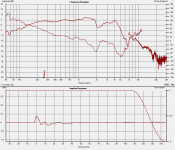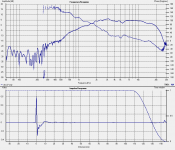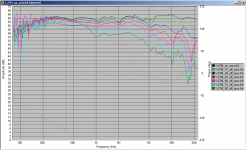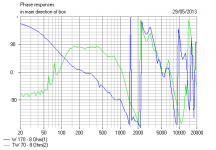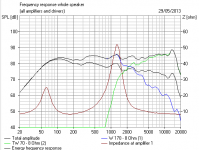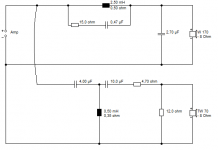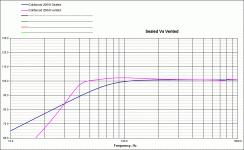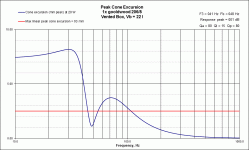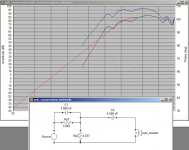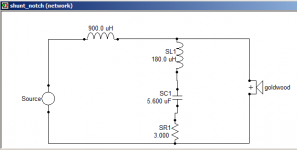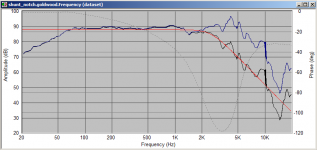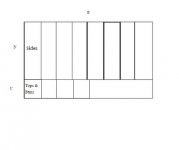I was thinking here: 15 Watt Mono L-Pad | 50-090 (50090) | Distributed By MCM at least the tweeter level can be brought down.
Parts Express provides a measurement of the woofer:
http://www.parts-express.com/pedocs/more-info/290-305-goldwood-gw-2068-more-info-3665.pdf
A measurement of the tweeter is here:
Measurements: Pyle cheap horn tweeter PH25 (272-104 $6.93)
Both drivers do not behave well in the upper frequency range.
http://www.parts-express.com/pedocs/more-info/290-305-goldwood-gw-2068-more-info-3665.pdf
A measurement of the tweeter is here:
Measurements: Pyle cheap horn tweeter PH25 (272-104 $6.93)
Both drivers do not behave well in the upper frequency range.
A notch filter at arond 4K on the woofer looks like a good starting point. that should tame it a little, and may allow (with suitable tweeter) a cross at somewhere between 2 and 3 Khz.
Having been through an exercise of trying to deal with a driver that presented a similar response (though not as peaky) and coming out with a good result, it is surprising what you can actually achieve (though I will certainly not claim it is easy!!).
Below I've attached a response plot (in box) of my MW144's which are not dissimilar to the OP's woofers SPL curve in a lot of respects. I've attached these to show what is possible even when things look bad. Second pic is the tweeter that was mated with it (a DMS37), and third pic is the final result. Completely passive crossover. But designed with good measurements and simulation.
So what might at first look terrible can be bent into shape, and at least in my case it does sound good. crossover is at 2.8Khz 4th order bessel.
Having said that I think the chances of getting the tweeter in the first post to work with the woofer are extremely low!! Out of the two I'd be keeping the woofer
Tony.
Having been through an exercise of trying to deal with a driver that presented a similar response (though not as peaky) and coming out with a good result, it is surprising what you can actually achieve (though I will certainly not claim it is easy!!).
Below I've attached a response plot (in box) of my MW144's which are not dissimilar to the OP's woofers SPL curve in a lot of respects. I've attached these to show what is possible even when things look bad. Second pic is the tweeter that was mated with it (a DMS37), and third pic is the final result. Completely passive crossover. But designed with good measurements and simulation.
So what might at first look terrible can be bent into shape, and at least in my case it does sound good. crossover is at 2.8Khz 4th order bessel.
Having said that I think the chances of getting the tweeter in the first post to work with the woofer are extremely low!! Out of the two I'd be keeping the woofer
Tony.
Attachments
Last edited:
There is also the possibility of using a good 3inch driver to cover the treble, no problem crossing most of those down low enough and SLP/watt usually close enough above 300 or 400Hz, just need to use a small sealed cup behind the driver
eg
Visaton FRS8-8 3.3" Full-Range Speaker 8 Ohm 292-524
eg
Visaton FRS8-8 3.3" Full-Range Speaker 8 Ohm 292-524
A notch filter at arond 4K on the woofer looks like a good starting point. that should tame it a little, and may allow (with suitable tweeter) a cross at somewhere between 2 and 3 Khz.
Having been through an exercise of trying to deal with a driver that presented a similar response (though not as peaky) and coming out with a good result, it is surprising what you can actually achieve (though I will certainly not claim it is easy!!).
Below I've attached a response plot (in box) of my MW144's which are not dissimilar to the OP's woofers SPL curve in a lot of respects. I've attached these to show what is possible even when things look bad. Second pic is the tweeter that was mated with it (a DMS37), and third pic is the final result. Completely passive crossover. But designed with good measurements and simulation.
So what might at first look terrible can be bent into shape, and at least in my case it does sound good. crossover is at 2.8Khz 4th order bessel.
Having said that I think the chances of getting the tweeter in the first post to work with the woofer are extremely low!! Out of the two I'd be keeping the woofer
Tony.
Thanks very much for taking the time to respond. If one was to impulsively purchase these tweeters after getting his manhood handed to him in an audio forum, could you offer some crossover advice? Also, is there any way to salvage my original (PE reco'd) sealed cabinet volume, or will I have to increase volume and port to have any hope of fixing this mess?
Cheers.
Having had a play with the similar Visaton W170 woofer ( a parcel shelf car woofer....) and a TW-70, I fancy the 4" Goldwood GT-25 cone tweeter.
It all works rather well. The Woofer gets a typical 6" woofer's 5kHz notch. Lots of bafflestep for bass and a gentle rolloff. Crossover's a tidge lower than I would like ideally, but I don't think it'll sound too bad in a cubic foot or so. You adjust the attenuator on the treble so it stays around 9 ohms overall on a 6 ohm DC tweeter to get the treble level about right, but it won't be far off anyway. This tweeter is so cheap, what have you got to lose?
BTW, I assume it's a sealed unit, otherwise you build a tiny little box for it.
It all works rather well. The Woofer gets a typical 6" woofer's 5kHz notch. Lots of bafflestep for bass and a gentle rolloff. Crossover's a tidge lower than I would like ideally, but I don't think it'll sound too bad in a cubic foot or so. You adjust the attenuator on the treble so it stays around 9 ohms overall on a 6 ohm DC tweeter to get the treble level about right, but it won't be far off anyway. This tweeter is so cheap, what have you got to lose?
BTW, I assume it's a sealed unit, otherwise you build a tiny little box for it.
Attachments
You might be able to do something with the tweeter by using a small cap on it (maybe 2uF or less + an lpad with the series resistor bypassed (with perhaps a 1uf cap) That could flatten it out a bit. Then try crossing it at say 2.5K. Without seeing an impedance measurement of it, and power handling (I know it says 60W but they normaly qualify that with a X point and slope) it is a bit hard to tell if that would be doable though.
If I have time (a big if) I'll spltrace it and have a bit of a play in speaker workshop.
Tony.
If I have time (a big if) I'll spltrace it and have a bit of a play in speaker workshop.
Tony.
Note that above comment was wrt the original tweeter, not the pioneer. Without any graphs of the pioneer very difficult to say anything.
As was suggested earlier the woofer (if you want bass) would probably best be put in a vented enclosure. I modeled it sealed and vented in 22L (your 0.79 cubic feet) If tuned to around 48-50 Hz you might get something ok. But it will not handle much power (sealed won't either under 100Hz)
You may need to put in a high pass at 50Hz. It could probably handle about 20W if you did.
Anyway attached is graph comparing vented to sealed. bothwere using your cabinet size, vented tuned to 48Hz., sealed heavy stuffing.
I also realised that without an impedance plot of the tweeter doing any sims to try and work out something that could flatten it out a bit is probably a bit pointless. I could substitute in another tweeters impedance plot to get an idea, but it would be largely academic.
Tony.
As was suggested earlier the woofer (if you want bass) would probably best be put in a vented enclosure. I modeled it sealed and vented in 22L (your 0.79 cubic feet) If tuned to around 48-50 Hz you might get something ok. But it will not handle much power (sealed won't either under 100Hz)
You may need to put in a high pass at 50Hz. It could probably handle about 20W if you did.
Anyway attached is graph comparing vented to sealed. bothwere using your cabinet size, vented tuned to 48Hz., sealed heavy stuffing.
I also realised that without an impedance plot of the tweeter doing any sims to try and work out something that could flatten it out a bit is probably a bit pointless. I could substitute in another tweeters impedance plot to get an idea, but it would be largely academic.
Tony.
Attachments
ok as I said pretty academic (I used my dms37's impedance curve) but the attached is what I came up with very quickly. Note phase has not been extracted from the spl trace.
The red target is 3rd order butterworth at 2.5Khz idea being that if the woofer were tamed a bit with a notch and given a similar accoustic target the nature of the butterworth would fill in the hole in the response a bit. I've not don anything with the woofer.
I dropped the tweeter down to 85db which allows for 3db of baffle step correction on the woofer. Not all is as bad as it first seems
Blue is the original tweeter response curve.
Tony.
The red target is 3rd order butterworth at 2.5Khz idea being that if the woofer were tamed a bit with a notch and given a similar accoustic target the nature of the butterworth would fill in the hole in the response a bit. I've not don anything with the woofer.
I dropped the tweeter down to 85db which allows for 3db of baffle step correction on the woofer. Not all is as bad as it first seems
Blue is the original tweeter response curve.
Tony.
Attachments
So there is some hope then? 
A couple of questions -
How do I put together a notch for the woofer?
I've got some 1.75" flared port tubes - what length would be good for 48-50hz?
I'm using a 2x15W amp, so that should be okay?
Should I use any poly fill in the vented enclosure?
Thanks again for taking the time.
A couple of questions -
How do I put together a notch for the woofer?
I've got some 1.75" flared port tubes - what length would be good for 48-50hz?
I'm using a 2x15W amp, so that should be okay?
Should I use any poly fill in the vented enclosure?
Thanks again for taking the time.
http://www.diyaudio.com/forums/mult...assive-notch-filter-design-2.html#post3195932
might help with the notch
might help with the notch
I spltraced the goldwood tonight. I just put it into speakerworkshop as is, no phase extraction, no baffle step modeling, no box model just to see what could be done about the breakup peak.
I decided to try a series notch (as it is something new for me). Results are promising.
With baffle dimentions (to do a proper baffle step sim) and phase extracted properly, I think a quite workable crossover can probably be come up with. Something that should be far better than an off the shelf one anyway
Note this is for demo purposes only, not suggesting you should implement this as is
Tony.
I decided to try a series notch (as it is something new for me). Results are promising.
With baffle dimentions (to do a proper baffle step sim) and phase extracted properly, I think a quite workable crossover can probably be come up with. Something that should be far better than an off the shelf one anyway
Note this is for demo purposes only, not suggesting you should implement this as is
Tony.
Attachments
Looks great Tony, that may very well work out just fine.........Now to the tweeter, if we can roll up the tweeter starting at 7K to 20K, with a final at 20K rolled up 15Db.............that should even things out...........THEN, take the whole mess & drop it down 5DB...meandering about 90 Db. Your work on the woofer & cleaning up & evening out the tweeter should do fine..crossing at 2K. Crossovers are just not my forte'.
All this plus my "big ported box" proposal, might very well make a silk purse out of a Sows ear!
_______________________________________________________Rick..................
All this plus my "big ported box" proposal, might very well make a silk purse out of a Sows ear!
_______________________________________________________Rick..................
Last edited:
The capacitor for varying tweeter's emission works
I would start from a 0.47 value and see
I would then EQ the bass with a resistor.
Some strange ideas happening ...

The resistor ( about 1-2 Ω ) changes Qtb in the closed box .
Another strange idea is to put a big value capacitor before the woofer.
It also interacts with box values...
I would start from a 0.47 value and see
I would then EQ the bass with a resistor.
Some strange ideas happening ...

The resistor ( about 1-2 Ω ) changes Qtb in the closed box .
Another strange idea is to put a big value capacitor before the woofer.
It also interacts with box values...
Last edited:
I used the cap on the tweeter pad trick on my MTM build (in that case it was a 1uF) . I picked up the Idea from Wayne Parham's excellent articles on crossovers http://www.pispeakers.com/Speaker_Crossover_Lab.pdf (I can't remember if it was that exact thing but it was that article that led me to try it). This tweeter seemed to need a bit more. I could play with the sim and try and get something better, but the reality is it is quite a long way down after 10K so there is a limit as to just how much you can bring it up.
Another option is rather than using so much padding to use a much smaller value cap (main cap). What I posted a bit earlier I came up with pretty quickly. I didn't want to spend too much time on it without an actual proper impedance measurement.
Shaolin23 could you please post the baffle dimentions? I'd like to run it through Jeff Bagbies Response Modeler to get a more accurate bass FR curve.
Also from Charlies site software The article by Dave Dal Farra at the bottom of the page is basically the procedure I would take (except I use speaker workshop) for doing this properly (ie what I have posted so far isn't rigourous for actual implementation). UniBox is what I use for bass reflex modelling.
Shaolin I didn't answer your question about the port length/diameter, I did the unixbox sim quickly and didn't save, I'll have to fire it up again and get back to you Note it is just one possibility in a very large continuum of possible solutions
Note it is just one possibility in a very large continuum of possible solutions 
Tony.
Another option is rather than using so much padding to use a much smaller value cap (main cap). What I posted a bit earlier I came up with pretty quickly. I didn't want to spend too much time on it without an actual proper impedance measurement.
Shaolin23 could you please post the baffle dimentions? I'd like to run it through Jeff Bagbies Response Modeler to get a more accurate bass FR curve.
Also from Charlies site software The article by Dave Dal Farra at the bottom of the page is basically the procedure I would take (except I use speaker workshop) for doing this properly (ie what I have posted so far isn't rigourous for actual implementation). UniBox is what I use for bass reflex modelling.
Shaolin I didn't answer your question about the port length/diameter, I did the unixbox sim quickly and didn't save, I'll have to fire it up again and get back to you
Tony.
Looks great Tony, that may very well work out just fine.........Now to the tweeter, if we can roll up the tweeter starting at 7K to 20K, with a final at 20K rolled up 15Db.............that should even things out...........THEN, take the whole mess & drop it down 5DB...meandering about 90 Db. Your work on the woofer & cleaning up & evening out the tweeter should do fine..crossing at 2K. Crossovers are just not my forte'.
All this plus my "big ported box" proposal, might very well make a silk purse out of a Sows ear!
_______________________________________________________Rick..................
Thanks Rick
The response curve from 100Hz through 1Khz actually looks very good. I suspect that this driver would probably make a decent midrange in a three way.
When I bought my MW144's I was expecting an easy job with the crossover, as the manufacturers curves at the time were very smooth. The reality was quite different, so my introduction to designing your own crossover was rather harder than I would have liked. But I am a tenacious bastard and I worked at it until I got something I was happy with.
Now when I see a driver with some issues, I see it as just a bit more of a challenge
I'd really like to see a proper impedance plot of the tweeter. Not sure if Shaolin is interested in doing one?? Not that hard provided one has a full duplex sound card with line out and line in.
Tony.
The reason your not getting any useful bass output is that this woofer you now have is not suited to a sealed enclosure....it works far far better in a Ported enclosure. The simulation you used is crude to say the least. There are more complex simulations that consider far more variables & are therefore more accurate.
I ran your driver thru my simulator WinISD beta.....a common FREE simulation & found your bass driver will work just fine in a 3.018 cubic foot enclosure. With a common dimension ratio this works out to 13.763" by 17.341" by 21.848".
With a port size of 102mm diameter by 165mm long you can expect the bass to fade off at 30 Hz, or -3Db@30Hz as it is commonly written. A much smaller port should be used, perhaps half that diameter. Note that these are INSIDE dimensions. Changing the port size is easily plugged into this simulation.
Do yourself a big favor & build your box out of at least 3/4" material......I like to build with 1" material......I am assuming you used MDF or what's called Medium Density Fiberboard...you can reuse your stuffing in the other box, lining the insides.
_____________________________________________________Rick........
First up, you're giving a couple of 6" midbasses a 85L cabinet. Doesn't that strike you as at least a little bit excessive?
I'd go for 20L tuned to 60Hz. Gives a similar bass response to my boombox (which also has BSC), ~2.5dB peaking around 100Hz, -3dB around 60Hz. The alignment was recommended by Saturnus, and sounds rather good in practice.
A full BSC filter will be needed here - give it 6dB, so a 7-8ohm resistor in parallel with an inductor, the value of which will be determined by your cabinet dimensions.
Alternatively, have a read here: Baffle Step Compensation
Doing the BSC at line-level would be useful, as you won't be wasting power.
Chris
@ Chris, that looks pretty good actually! I was just playing around with unibox so already had it there. I have 22L as that is the OP's actual cabinet volume.
I was about to post 22L tuned to 42Hz as a possibility but I think that the 60 Hz tuning looks better (and the transient response certainly is). It would be interesting to see how that comes out adjusted for baffle step with the baffle dimentions.
plots for 60Hz tuning 22L cabinet below. Power handling (at the OP's 15W) looks to be good as well.
edit: I've just attached the 42Hz tuning plots for comparison.
I was about to post 22L tuned to 42Hz as a possibility but I think that the 60 Hz tuning looks better (and the transient response certainly is). It would be interesting to see how that comes out adjusted for baffle step with the baffle dimentions.
plots for 60Hz tuning 22L cabinet below. Power handling (at the OP's 15W) looks to be good as well.
edit: I've just attached the 42Hz tuning plots for comparison.
Attachments
-
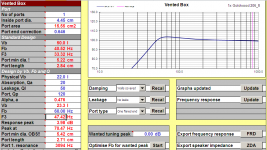 GW_60Hz.png53.3 KB · Views: 22
GW_60Hz.png53.3 KB · Views: 22 -
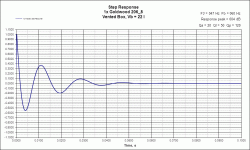 VB Step Response Goldwood 206_8.gif26.6 KB · Views: 20
VB Step Response Goldwood 206_8.gif26.6 KB · Views: 20 -
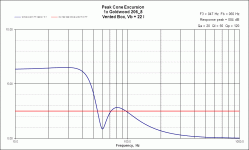 VB Excursion Goldwood 206_8.gif21.2 KB · Views: 69
VB Excursion Goldwood 206_8.gif21.2 KB · Views: 69 -
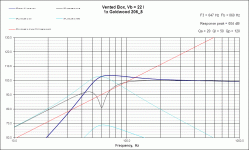 VB Response Goldwood 206_8.gif30.6 KB · Views: 67
VB Response Goldwood 206_8.gif30.6 KB · Views: 67 -
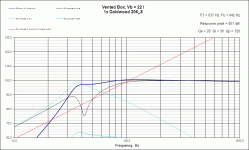 VB Response Goldwood 206_8_42Hz.gif30.6 KB · Views: 32
VB Response Goldwood 206_8_42Hz.gif30.6 KB · Views: 32 -
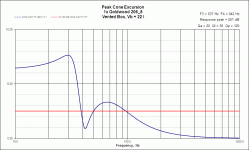 VB Excursion Goldwood 206_8_42Hz.gif21.8 KB · Views: 27
VB Excursion Goldwood 206_8_42Hz.gif21.8 KB · Views: 27 -
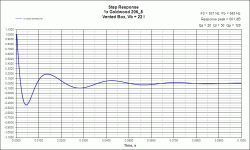 VB Step Response Goldwood 206_8_42Hz.gif25.9 KB · Views: 35
VB Step Response Goldwood 206_8_42Hz.gif25.9 KB · Views: 35 -
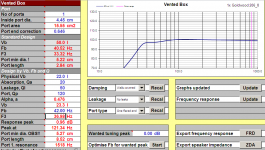 GW_42Hz.png52.7 KB · Views: 29
GW_42Hz.png52.7 KB · Views: 29
Last edited:
- Status
- This old topic is closed. If you want to reopen this topic, contact a moderator using the "Report Post" button.
- Home
- Loudspeakers
- Multi-Way
- Help with bass response on my first build...
